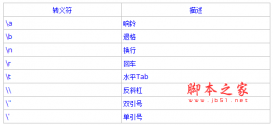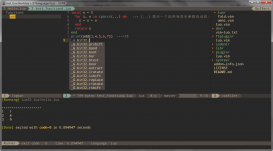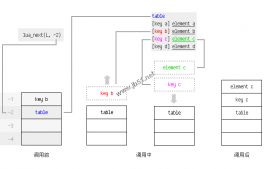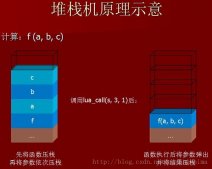关系表类型,这是一个很强大的类型。我们可以把这个类型看作是一个数组。只是 C语言的数组,只能用正整数来作索引; 在Lua中,你可以用任意类型的值来作数组的索引,但这个值不能是 nil。同样,在C语言中,数组的内容只允许一种类型;在 Lua中,你也可以用任意类型的值来作数组的内容,nil也可以。
基本介绍
注意三点:
第一,所有元素之间,总是用逗号 "," 隔开;
第二,所有索引值都需要用 "["和"]" 括起来;如果是字符串,还可以去掉引号和中括号; 即如果没有[]括起,则认为是字符串索引
第三,如果不写索引,则索引就会被认为是数字,并按顺序自动从 1往后编;
例如:
tt = {"hello" ,33}
value = 4
tab = {[tt] = "table",key = value, ["flag" ] = nil, 11}
print(tab[tt])
print(tab.key)
print(tab[1 ])
以上写法都是对的。
look = {[www] = "ok"}这样是不对的,www没有赋值,所以默认为nil因此出错table index is nil
---
temp = 1
tab = {[temp] = 1, 11}
print(tab[temp]) --此时的结果是11,因为11没有显式对应的key,因此从1开始,如果前面定义了,则覆盖其value
---
temp = 2
tab = {[temp] = 1, 11}
temp = 1
print(tab[temp]) -- 结果是11,虽然定义时[temp] = 1,但是后来我们改变了temp的值,所以指向另外的key了
以上可知:
1.对于字符串,在{}定义时,可以key = value, 也可以["flag"] = nil,索引都是string类型,对于非nil类型变量(包括字符串),都可以[variable]=value的方式
2.使用table时,对于字符串,可以通过.的方式访问,也可以通过[]方式访问。tab[a],tab[b],只要a==b那么tab[a]可以访问到tab[b]的值
3.不管定义索引时用的是常量还是变量,最终table中value的索引key是常量,不会随变量的改变而变化该value的key
嵌套
tb11= {tb12 = {bool = true}} -- simple, it's a table IN a table :)
-- Call magic!
print(tb11.tb12.bool ) -- works fine, since it's calling the key and value correctly.
print(tab11["tb12" ].bool ) --same as line 33
print(tab11.tb12 ["bool"]) --same as line 33
print(tab11["tb12" ]["bool"]) --same as line 33
修改table的value
--Altering a table's content. Basically manipulating the values of the keys.
lucky= {john="chips" ,jane ="lemonade",jolene="egg salad" }
lucky.jolene = "fruit salad" --changed the value to "fruit salad" instead of "egg salad"
lucky.jerry = "fagaso food" -- adding a new key-value pair to the container lucky.
lucky.john = nil -- remove john from giving anything or from being a key.
table的易变性
a = {}; b = a;
print(a == b) --> true
c,d = {},{};
print(c == d) -->false
table库函数使用
-----------------------------------------------------------
1. table.sort (table [, comp])
Sorts table elements in a given order, in-place, from table[1] to table[n], where n is the length of the table. If comp is given, then it must be a function that receives two table elements, and returns true when the first is less than the second (so that not comp(a[i+1],a[i]) will be true after the sort). If comp is not given, then the standard Lua operator < is used instead.
The sort algorithm is not stable; that is, elements considered equal by the given order may have their relative positions changed by the sort.
name = {"you" ,"me", "him","bill" }
--table.sort - only works with arrays!
table.sort(name)
for k, v in ipairs( name) do
print( k,v)
end
--table.sort uses callbacks. a function that is writtent to be called by a library function.
function cmp( a, b)
if string.sub(a,2 ,2) < string.sub(b,2 ,2) then
return true
else
return false
end
end
table.sort(name, cmp)
for k, v in ipairs( name) do
print( k,v)
end
2. table.insert (table, [pos,] value)
Inserts element value at position pos in table, shifting up other elements to open space, if necessary. The default value for pos is n+1, where n is the length of the table so that a call table.insert(t,x) inserts x at the end of table t.
--table.insert --an easy to copy a table to another table or adding elements to an array.!
foo = {"a" ,"c", "d"}
bar = {}
function printt( table)
for i=1 ,#table do
print(i,table [i ])
end
end
print("before insert:" )
printt(foo)
table.insert(foo,2 ,"b")
print("after insert" )
printt(foo)
3. table.concat (table [, sep [, i [, j]]])
Given an array where all elements are strings or numbers, returns table[i]..sep..table[i+1] ··· sep..table[j]. The default value for sep is the empty string, the default for i is 1, and the default for j is the length of the table. If i is greater than j, returns the empty string.
--table.concat does what it implies. Takes an array and concates to one string.
num = {1 ,2, 3,4,5 ,6}
print(table.concat (num ,"<"))
4. table.remove (table [, pos])
Removes from table the element at position pos, shifting down other elements to close the space, if necessary. Returns the value of the removed element. The default value for pos is n, where n is the length of the table, so that a call table.remove(t) removes the last element of table t.
abc = {"a" ,"b", "c"}
print(table.remove (abc ,2))
print("abc length = " .. #abc)
5. table.maxn (table)
Returns the largest positive numerical index of the given table, or zero if the table has no positive numerical indices. (To do its job this function does a linear traversal of the whole table.)
--table.maxn
apple = {"a" ,"p",[ 5]="e"}
print(table.maxn (apple )) -- 5
duck = {[-2 ]=3,[- 1]=0}
print(table.maxn (duck )) -- 0
面向对象编程
--note for a object to work, it needs a closure(inner function with an upvalue(a local value from a higher scope))
--note: the more closures made, the slower the program would run.
function mg1( n)
local function get ()
return n ;
end
local function inc (m )
n = n +m ;
end
return {get = get, inc= inc}
end
object = mg1(50 )
print(object.get ())
print(object["get" ]())
object.inc(2 )
print(object.get ())
----------------------------------------
do
local function get (o )
return o.one
end
local function inc (self , two )
self.one = self.one + two
end
function mg3 (one )
return {one = one , get = get , inc = inc }
end
end
a = mg3(50 )
a:get()
a.inc(a,2 )
print(a:get())
----------------------------------------
do
local T = {};
function T:get()
return self.n ;
end
function T:inc(m)
self.n = self.n + m ;
end
function mg4 ( n )
return {n = n , get =T.get , inc =T.inc }
end
end
c = mg4(30 )
print(c:get())
c:inc(4 )
print(c:get())
(完)






